Following the nice lunch on the island of Büyükada, we walked for a little while yet in the area surrounding the ferry terminal. Along the way we tried some local ice-cream that had a very weird note in all the versions regardless of the taste we both chose – as if they had put in some sheep suet in order to prevent the formation of little crystals. In any case, I did not like it. But, before leaving the island we stopped for a nice coffee and thus this casual, relaxed excursion was completed. On our return journey, as the day was getting closer to its end, the ship we were on made stops at a few more small islands that belong to the group of the Princes’ Islands.
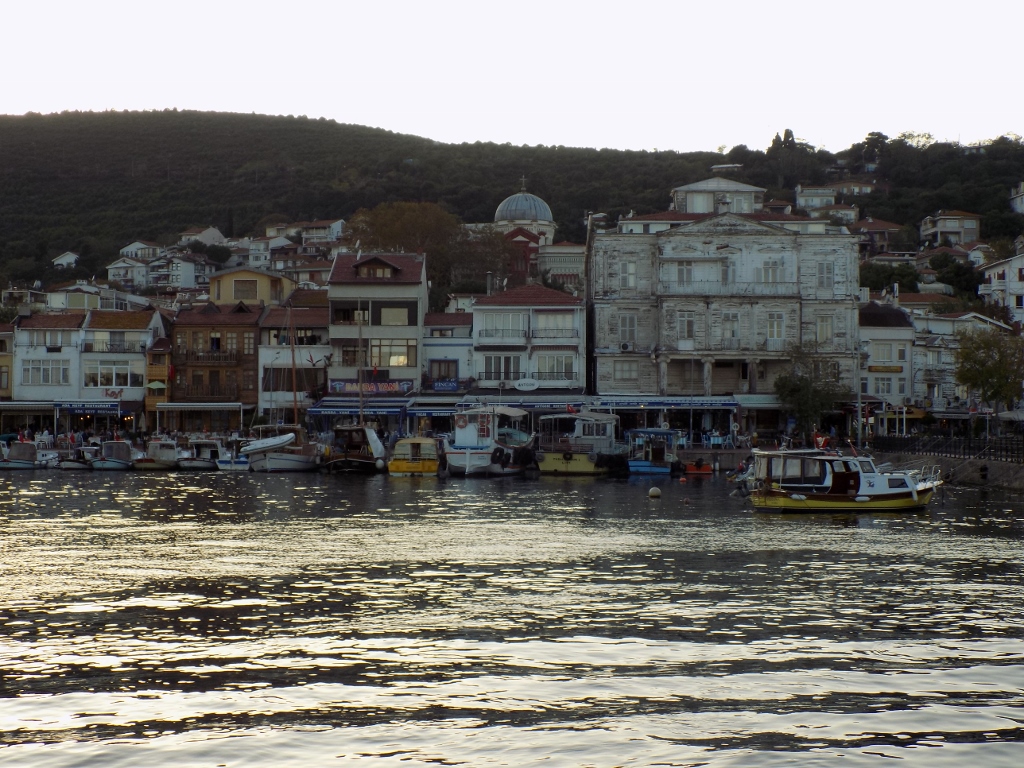 Port at one of the Princes’ Islands
Port at one of the Princes’ Islands
The return was fabulous because the night fell in the meantime and thus I could enjoy intensely in the night sights of Istanbul as seen from the sea.
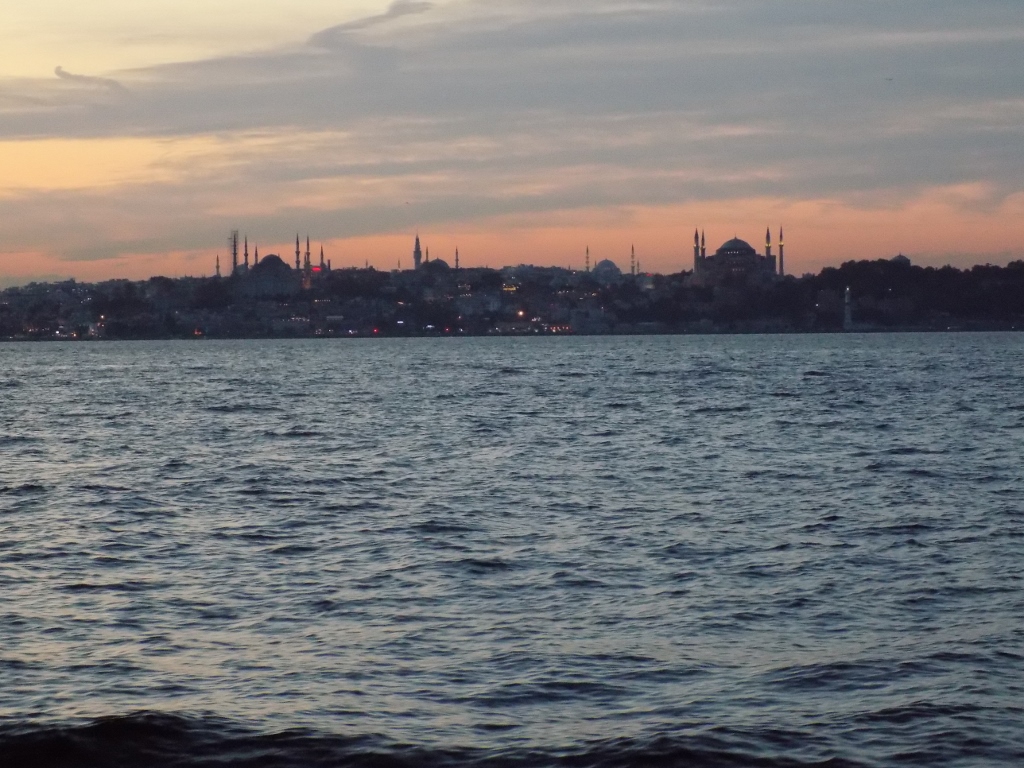 Blue Mosque is to the left and Ayasofya is to the right
Blue Mosque is to the left and Ayasofya is to the right
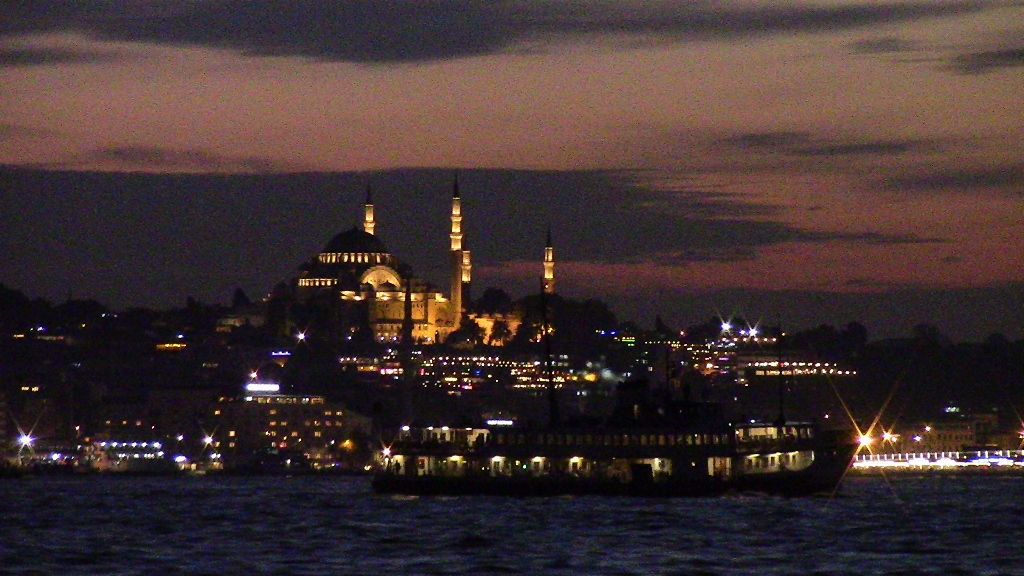 Süleymaniye Mosque at night
Süleymaniye Mosque at night
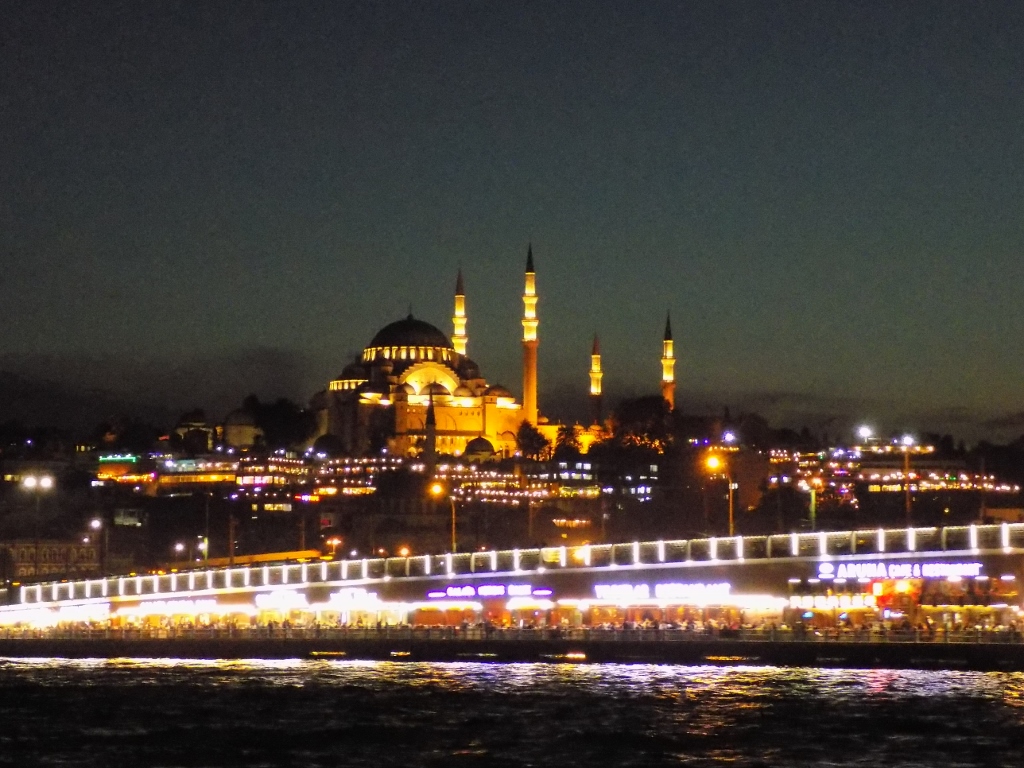 Süleymaniye Mosque and the Galata bridge
Süleymaniye Mosque and the Galata bridge
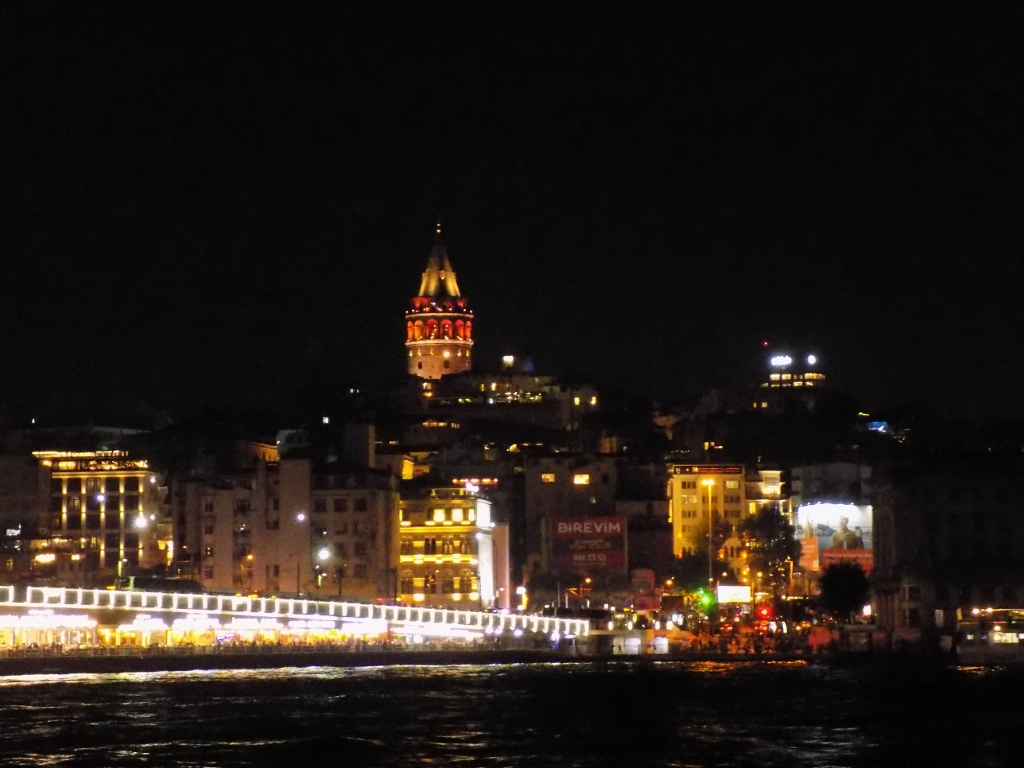 Galata Bridge and Tower at night
Galata Bridge and Tower at night
From the port we took a tram to go back to the Sultanahmet Square and then across the square we walked in the direction of our hotel.
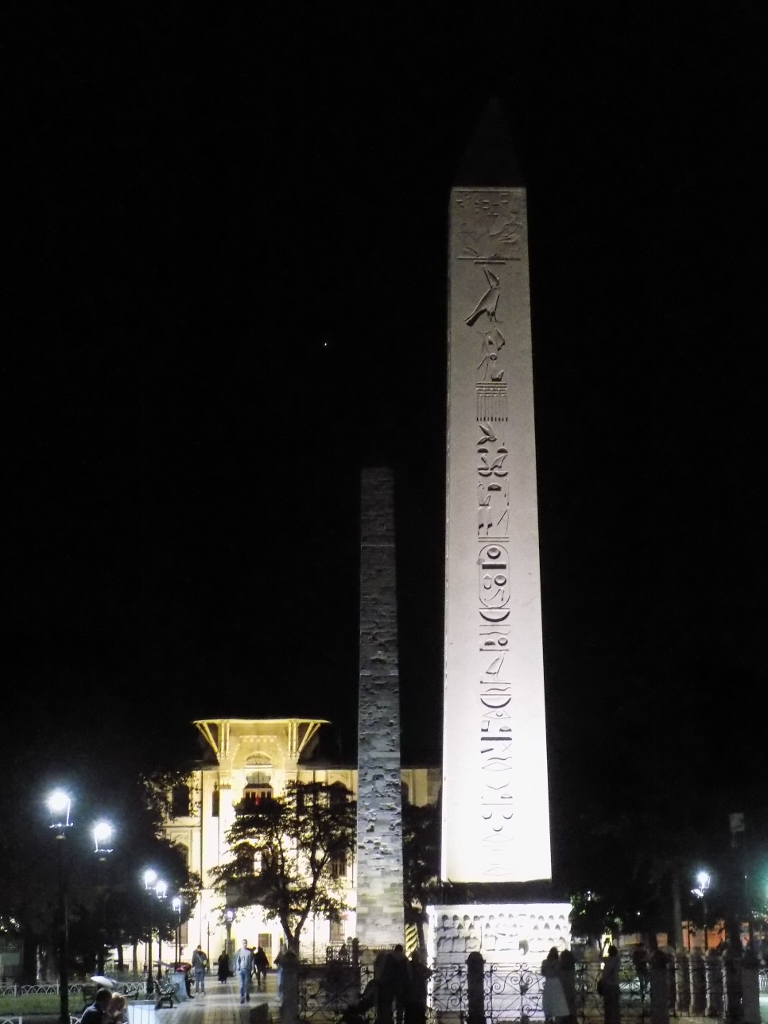 Sultanahmet Square at night
Sultanahmet Square at night
The next day was in a way special (at least in my head) and so I adjusted the visiting plan accordingly. Namely, before going to Istanbul, I realised that this day will be the anniversary of the death of the great Grand Vizier Sokollu Mehmet Pasha. Sokollu Mehmet Pasha was born as an Orthodox Serb, by the name of Bajica Nenadić, on the territory of the present-day Bosnia and Herzegovina, but he was taken away from his family while still a boy, as a part of the regular practice of the Ottomans to take the so-called “blood tax”, after which he was brought to Istanbul and converted to Islam. That was quite a regular occurrence and many children from the Balkans ended up as janissaries or working in administration, while some of them managed to make fine careers. The most successful among them is certainly Sokollu Mehmet Pasha who rose to the position of the Grand Vizier (today’s equivalent: the Prime Minister) at the time of the most successful Ottoman sultan, Suleiman the Magnificent. He also kept the position during the reign of the son and the grandson of this famous sultan. He was assassinated while serving under Sultan Murad III on 11 October 1579 and on this day when Sneža and I were in Istanbul it was exactly 440 years since his death.
Here is the map of what we visited on this day, but let there be no mistake, we did not cover it all on foot, but rather used public transportation for some longer distances.
Still, the day first started with wonderful Sun rise which I enjoyed during my breakfast.
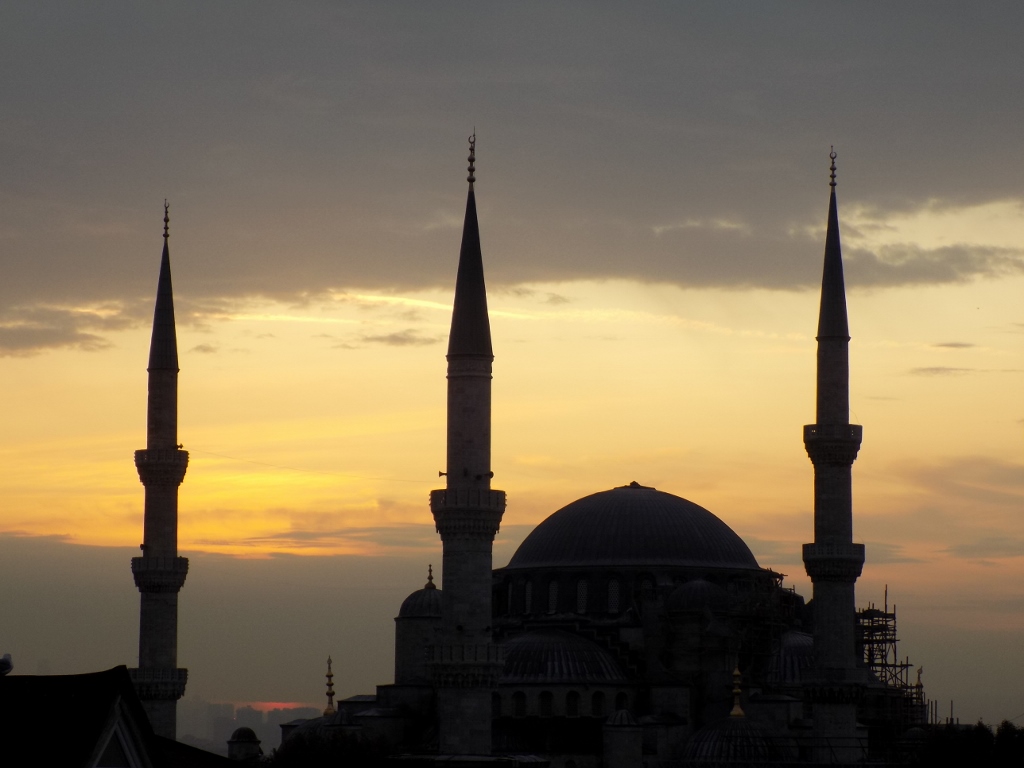 The Sun is coming up behind the Blue Mosque
The Sun is coming up behind the Blue Mosque
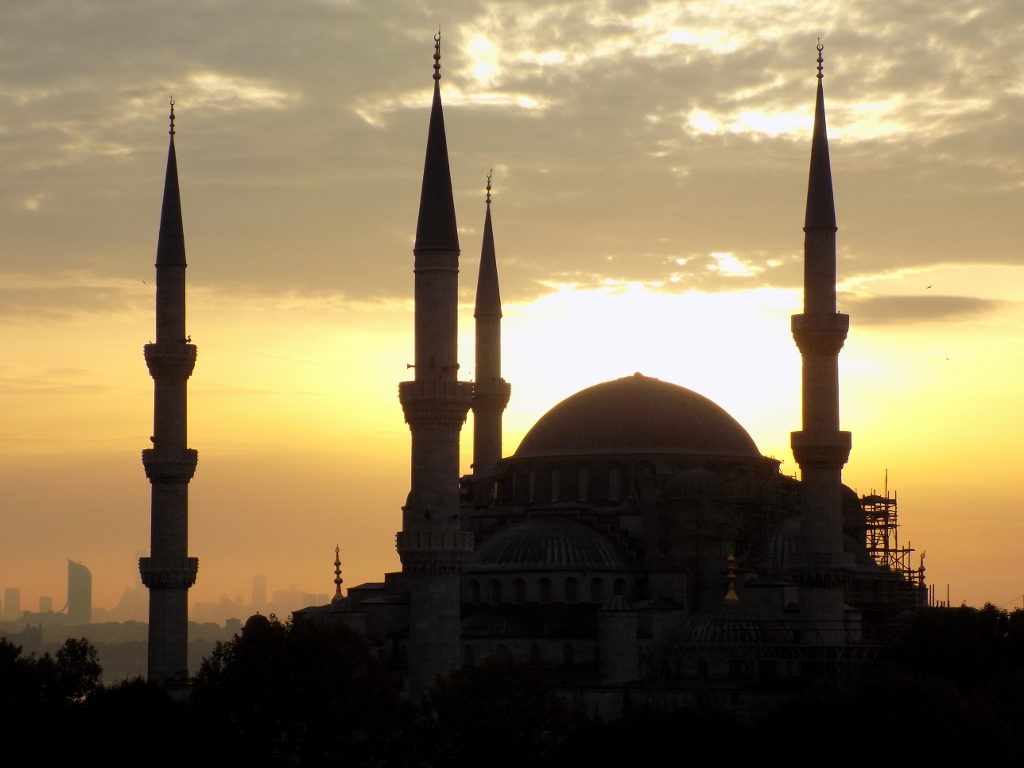 The Sun is coming up behind the Blue Mosque
The Sun is coming up behind the Blue Mosque
The beginning of our visits of this day started precisely from one of the mosques built by Sokollu Mehmet Pasha and designed by architect Sinan.
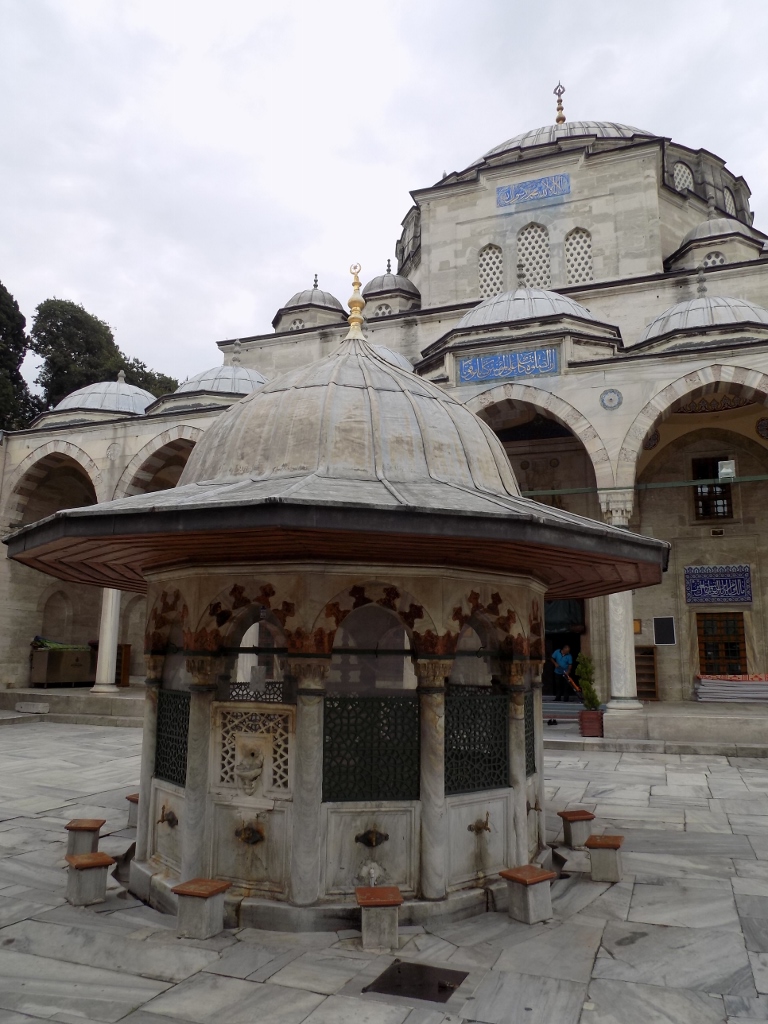 Sokollu Mehmet Pasha Mosque
Sokollu Mehmet Pasha Mosque
We had already been in one of the mosques built in Istanbul by Sokollu Mehmet Pasha and designed by Mimar Sinan. I wrote about that mosque in the 5th part of the travel stories about Istanbul (https://www.svudapodji.com/en/istanbul-5/). This is another mosque and it is located some five minutes on foot away from the Sultanahmet Square. When we got there this morning, the prayer had just finished and the man in charge of the maintenance of the mosque said we could return and visit it later, since he had to vacuum-clean it and clear it up. That’s why on this occasion we just walked a little around the forecourt and then continued with our planned visits elsewhere, with an idea to return here some other time.
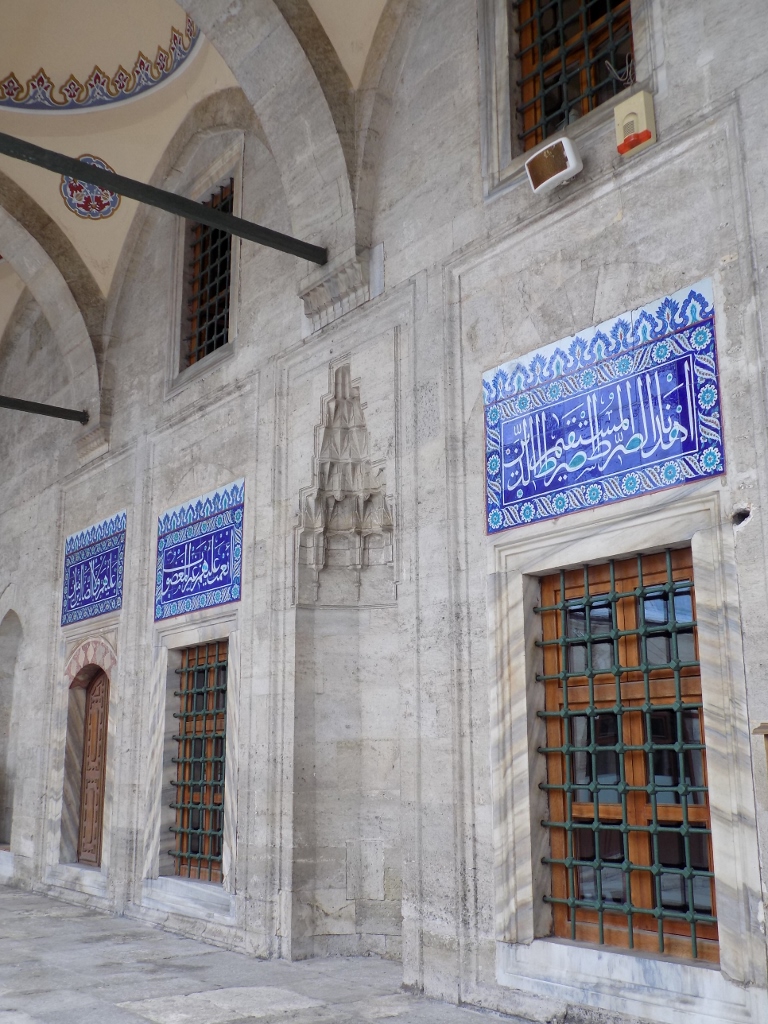 Sokollu Mehmet Pasha Mosque, details
Sokollu Mehmet Pasha Mosque, details
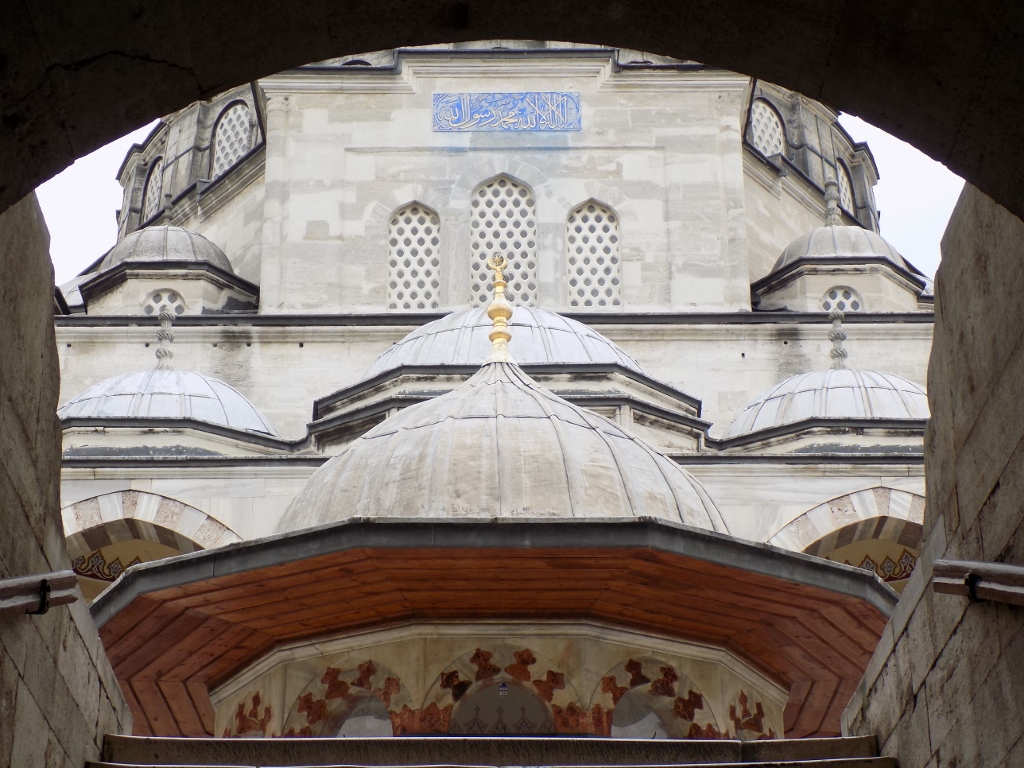 Sokollu Mehmet Pasha Mosque, details
Sokollu Mehmet Pasha Mosque, details
So, we continued going down the hill in the direction of the Sea of Marmara. We zigzagged a little, but we did not mind since there are some very nice and picturesque streets here.
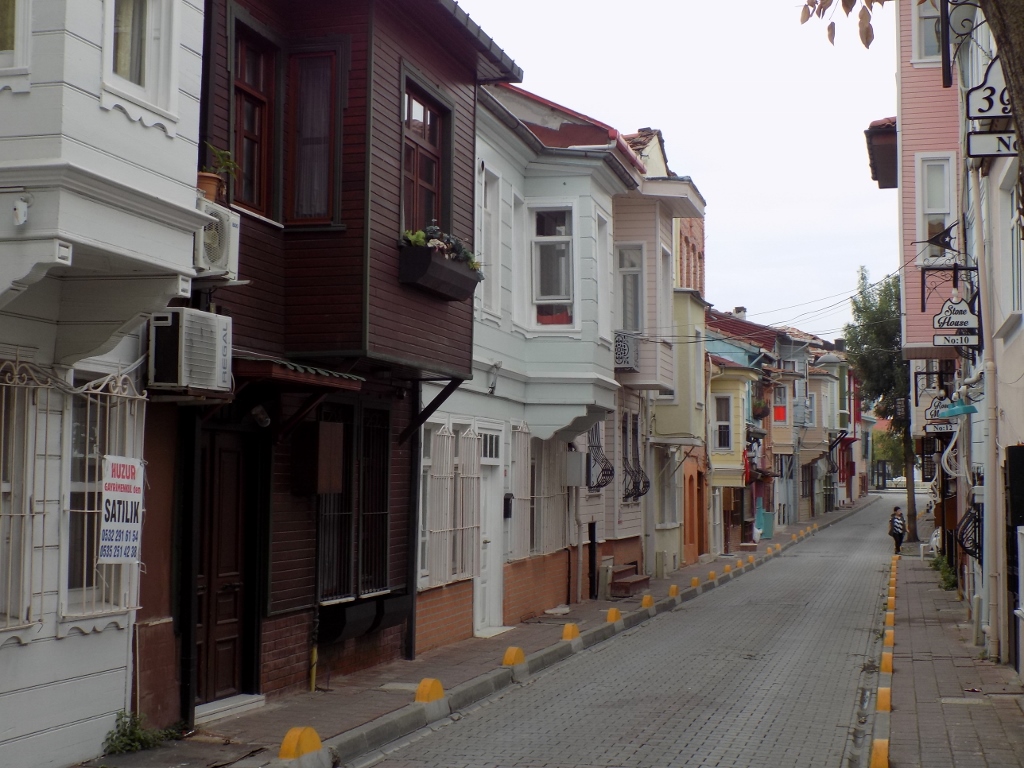 A street close to Little Hagia Sophia
A street close to Little Hagia Sophia
Our next destination was the Kucuk Ayasofya, i.e., the Little Hagia Sophia Mosque which was originally the Church of the Saints Sergius and Bacchus. This church was built by Emperor Justinian and his wife Empress Theodora between 527 and 536.
To start with, however, in front of the church we came across a man who worked as a shoeshiner and was sitting there waiting for customers. Since there was nobody else around except him and the two of us and we both had leather footwear, we decided to give him some work. For me, this was the first time somebody else shined my shoes, but I think one needs to try different things in life, especially because this man earned his living this way.
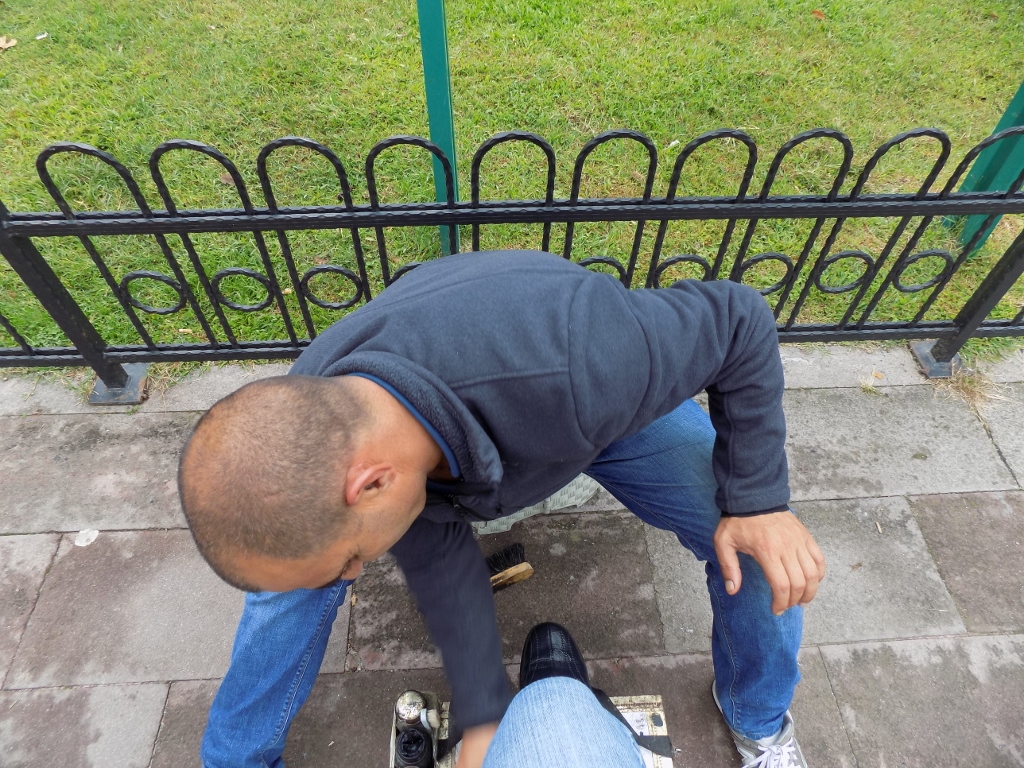 The shining of my shoe is going on
The shining of my shoe is going on
When we got out of the Little Hagia Sophia Mosque somewhat later, he and his equipment were no longer there. We concluded that we must have paid him enough that he did not have to work any longer that day, so in addition to our shining shoes, we were content hoping that the money went for the support of his numerous family he was telling us about while he was working.
But, let me go back to the edifice in front of us. It was turned into a mosque at the end of the 15th century.
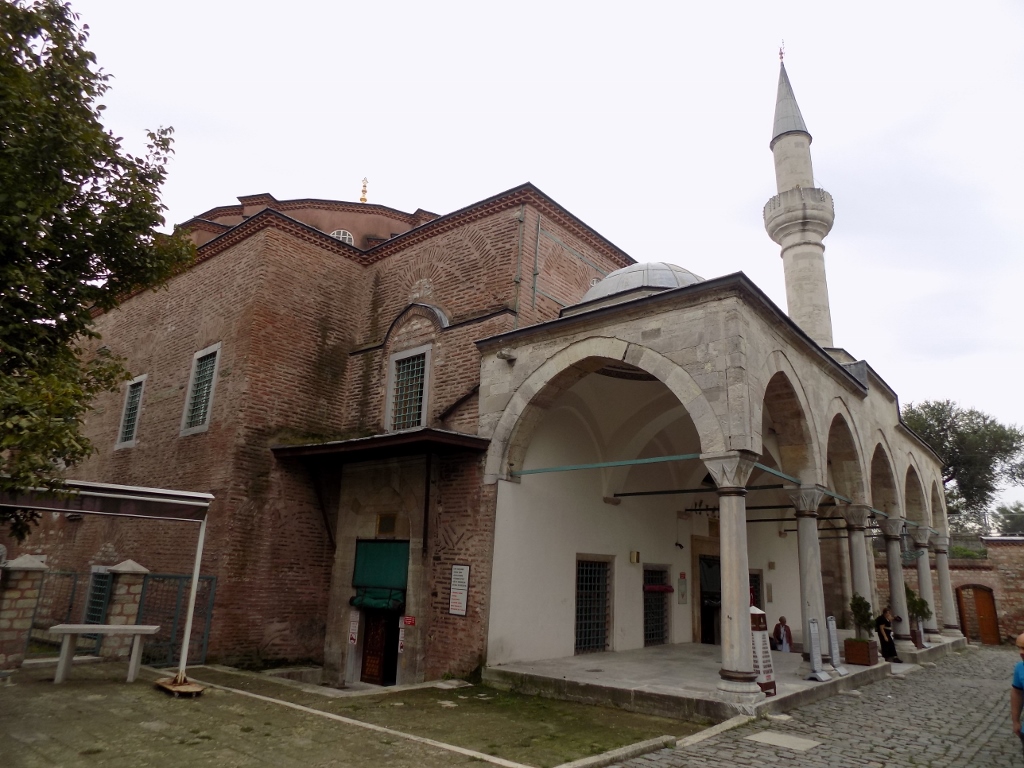 Kucuk Ayasofya Mosque
Kucuk Ayasofya Mosque
Today, there are no mosaics and frescoes here, but there is some very nice stone decoration in the shape of cornices and columns.
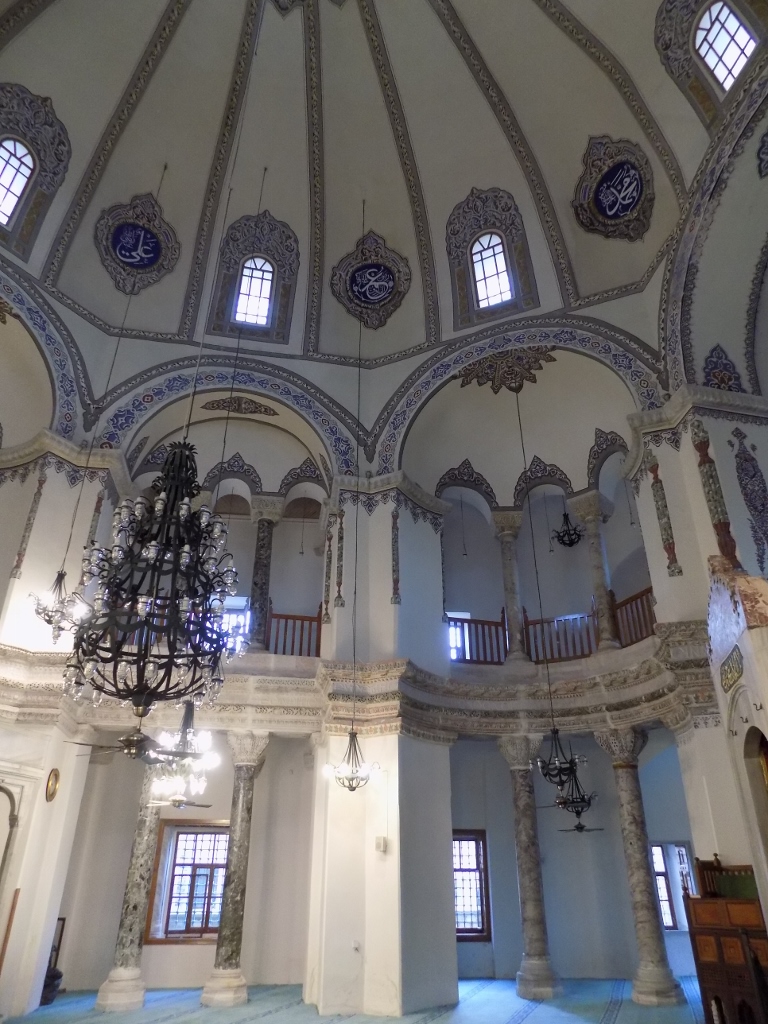 Kucuk Ayasofya Mosque
Kucuk Ayasofya Mosque
This was one of the most beautiful religious edifices from the times of Byzantium. What makes it special, like in the case of Hagia Sophia and Hagia Irene is the architectural solution where the central dome covers the entire plan of the naos.
After this we headed for a bus stop where we were to catch transportation to the Theodosian Walls, but in the meantime I had, at least for me, a very impressive, albeit superficial experience. Namely, from the Kucuk Ayasofya Mosque the two of us moved in the direction of the Sea of Marmara, but then we came to a street that crossed our path and all we could see behind it were some apparently uninterrupted walls, so without much hesitation and talk, we simply turned to the right. At that point, a man who was working there cleaning the street addressed us and talking in Turkish showed us using his hands and arms another direction that we were apparently supposed to follow. There is no need to say that the two of us did not understand any of the WORDS he was saying and we had not even asked him anything previously, however, it was completely clear to us that he was showing us which way we should go (in order to get to the bus stop). What made such a strong and lasting impression is the level of awareness of this man who performed manual work that within our minds is located rather low on the scale of economic success, but he did have one of the strongest presence I have encountered in my life. He saw the two of us, it was clear to him we were visitors and quite correctly concluded that we wanted to go to the main street where the bus stop was. In order to help us not to go round and round, he showed us the right way that then led us to a gate in the ramparts that could not be seen from the place where we met him. Much more than less walking, it meant to me and I was quite glad that I met a person who at least at that point in time was absolutely aware and present at the place of his existence.
Anyway, soon we caught the city bus and reached the Marble Tower.
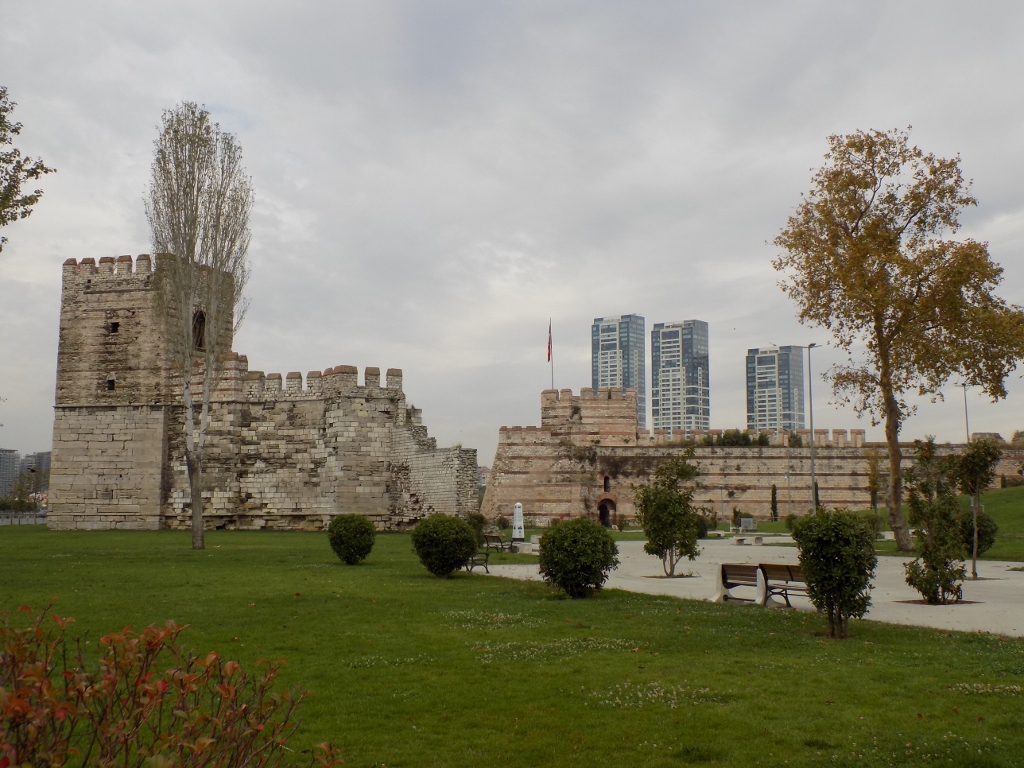 Marble Tower
Marble Tower
The construction of defence walls that led from the Sea of Marmara to the Golden Horn bay was ordered in the 5th century by the Emperor of the East Roman Empire Theodosius II and they are called after him – the Theodosian Walls. The walls are 7,620 m long and they start from the Marble Tower the foundations of which were immersed in the sea originally, but meanwhile the shore kept being filled with soil and nowadays the remains of this tower are completely out on dry land.
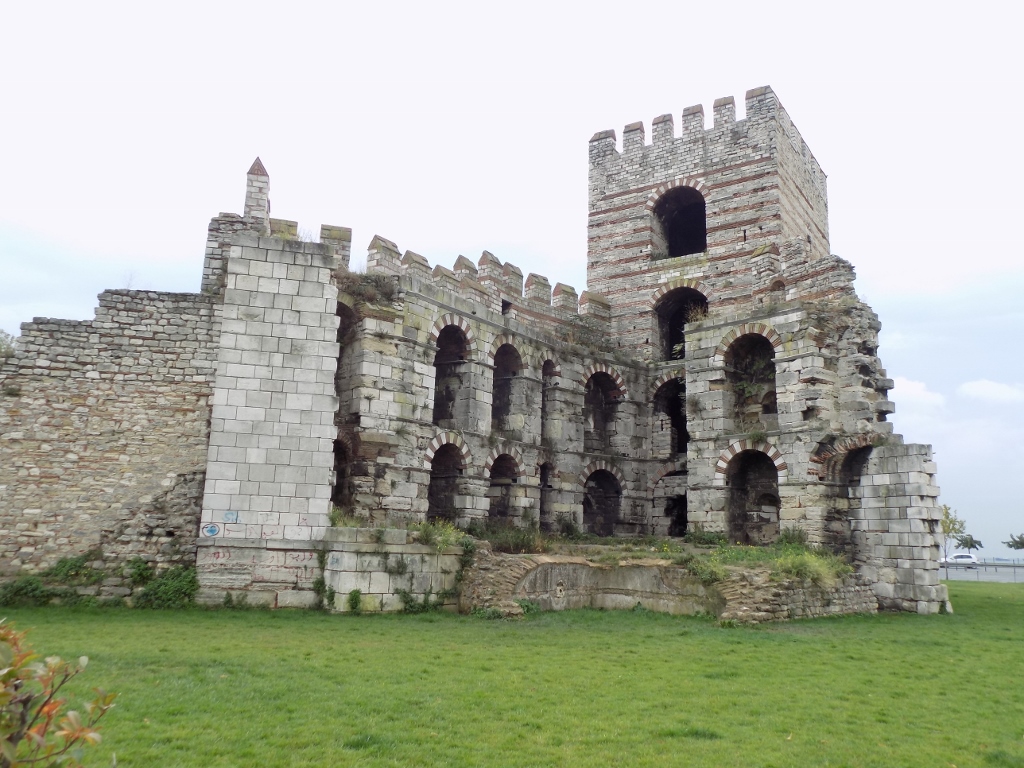 Marble Tower
Marble Tower
These defence walls of Constantinople were of exceptional significance and today, together with three other ensembles, they are inscribed in the UNESCO’s World Heritage List as “Historic Areas of Istanbul.” For this reason, Sneža and I decided to walk beside them. After the actual experience I don’t think this was the brightest idea I have ever had (the walking goes on and on, you almost constantly go uphill, its rather monotonous, etc.), but this is what it was. On the other hand, I do think it is a good thing to see the ramparts and even walk a little beside them, but one can pass by them and see them also by doing this from one of the city buses that drive parallel to the walls.
Close to the Marble Tower there is the Yedikule fortress with its Golden Gate that was used when Roman and Byzantine emperors needed to enter the city ceremoniously. Today, it is not so. Sneža and I were properly keen on seeing the fortress, but because of the present-day traffic and other infrastructure, essentially completely confused, we had to go around it in order, eventually and barely, to find it and get to a gate through which in theory it is possible to enter the fortress.
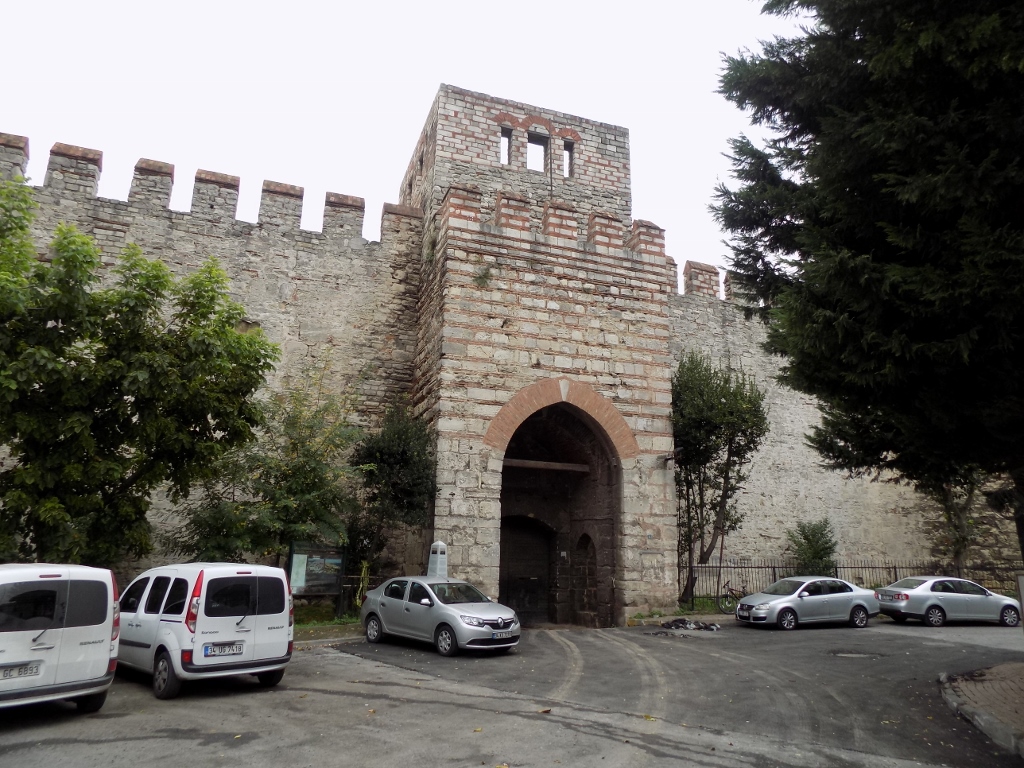 One of the entrances into the Yedikule fortress
One of the entrances into the Yedikule fortress
I say “in theory,” since the gate was locked, but it was possible to peer inside. Here is what I could see there:
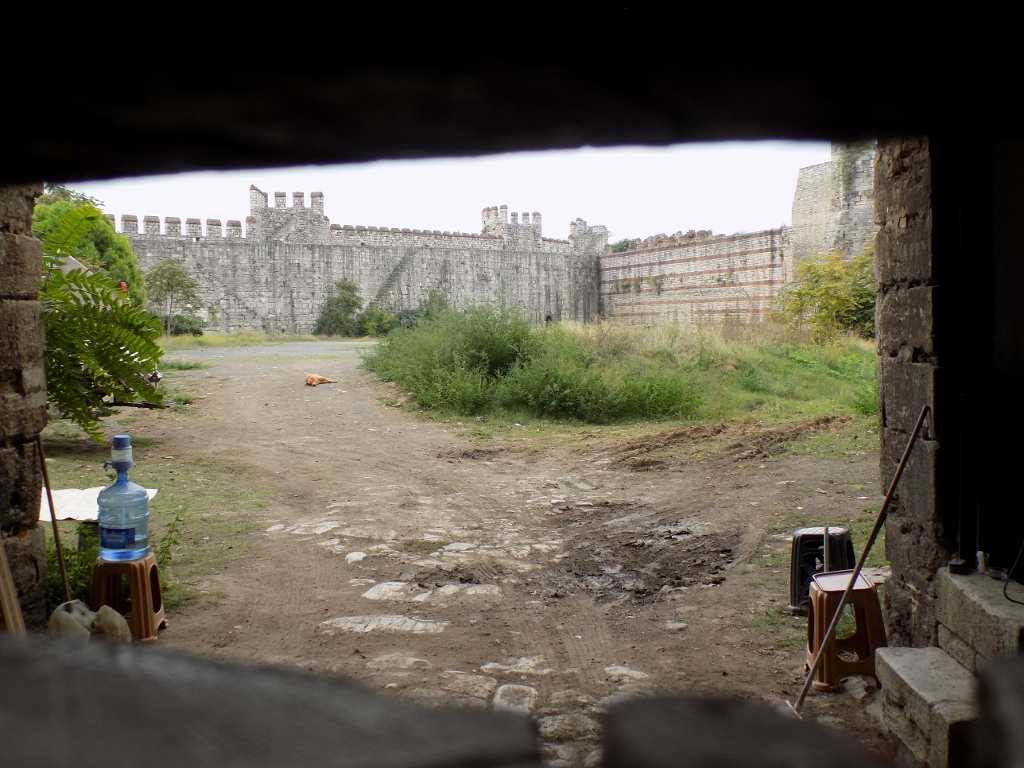 Interior of the Yedikule fortress
Interior of the Yedikule fortress
As for the Golden Gate, nowadays it is not so easy to see it because it is hidden by greenery and also between the gate and the possible viewing point in the shape of a street a densely filled cemetery has developed over time. I even climbed there in order to have a better view at the gate, but the results were meagre.
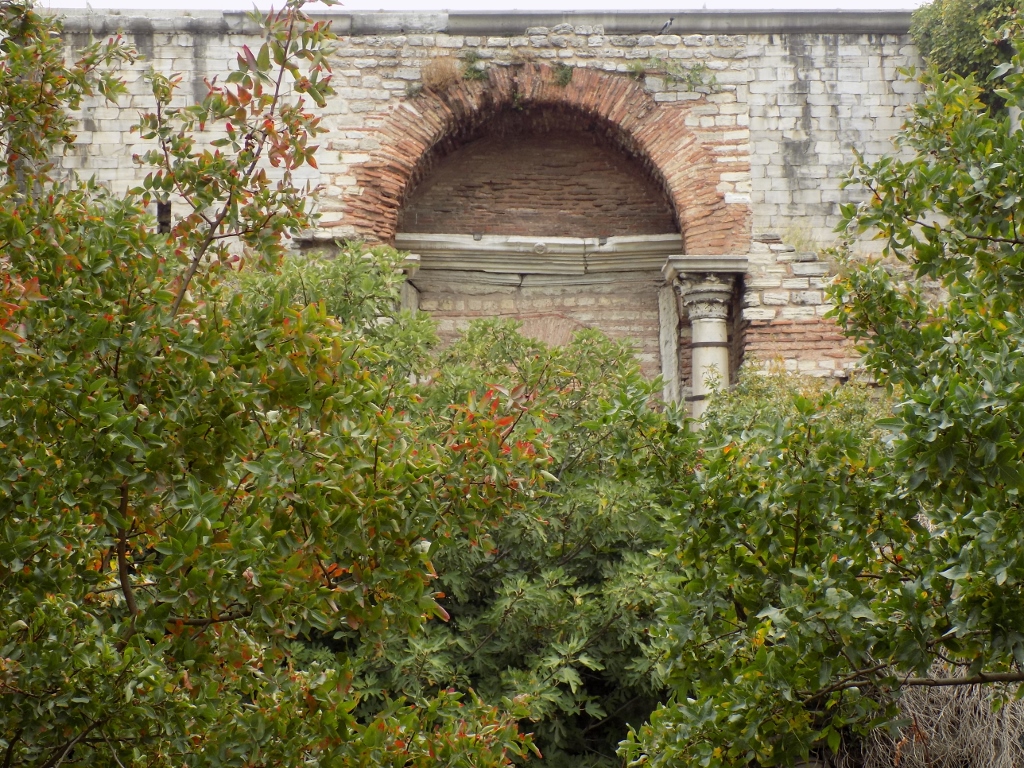 Detail of the exterior wall of the Yedikule fortress
Detail of the exterior wall of the Yedikule fortress
Still, we could have a superficial glimpse of the Golden Gate with two square-planned side towers once we started walking parallel to the walls in the north-bound direction.
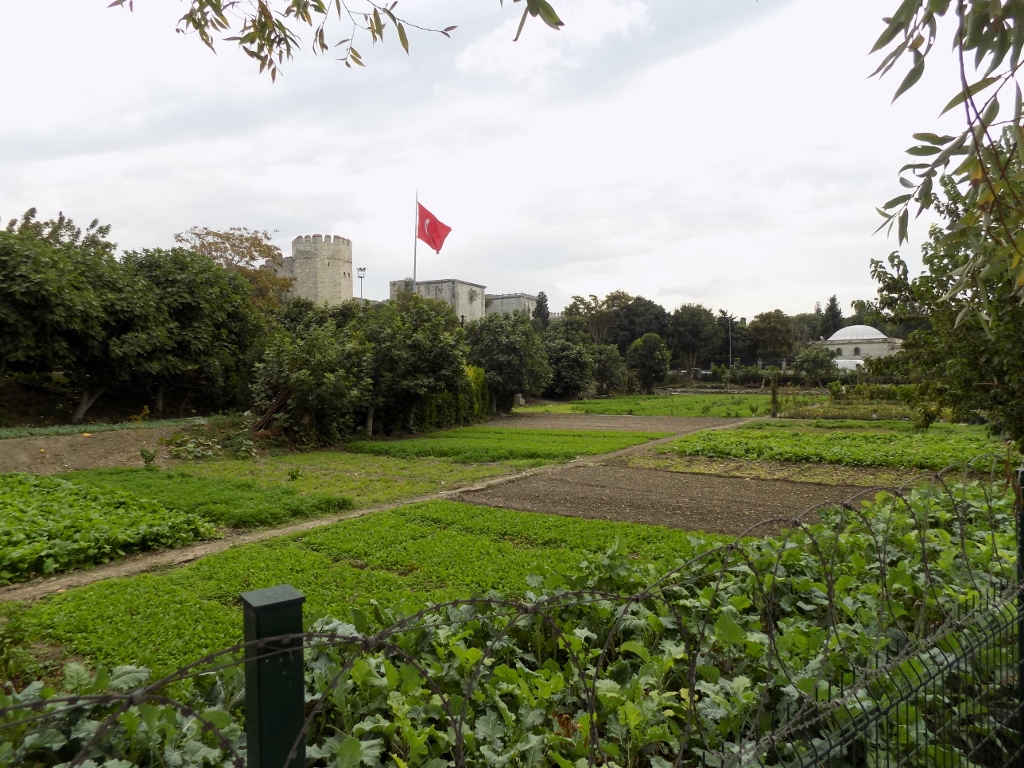 Tops of the towers by the Golden Gate
Tops of the towers by the Golden Gate
Well, now, as it may be seen in the photo above, there are quite a lot of land parcels here where different crops are grown. And this is so almost the entire length of the walls...
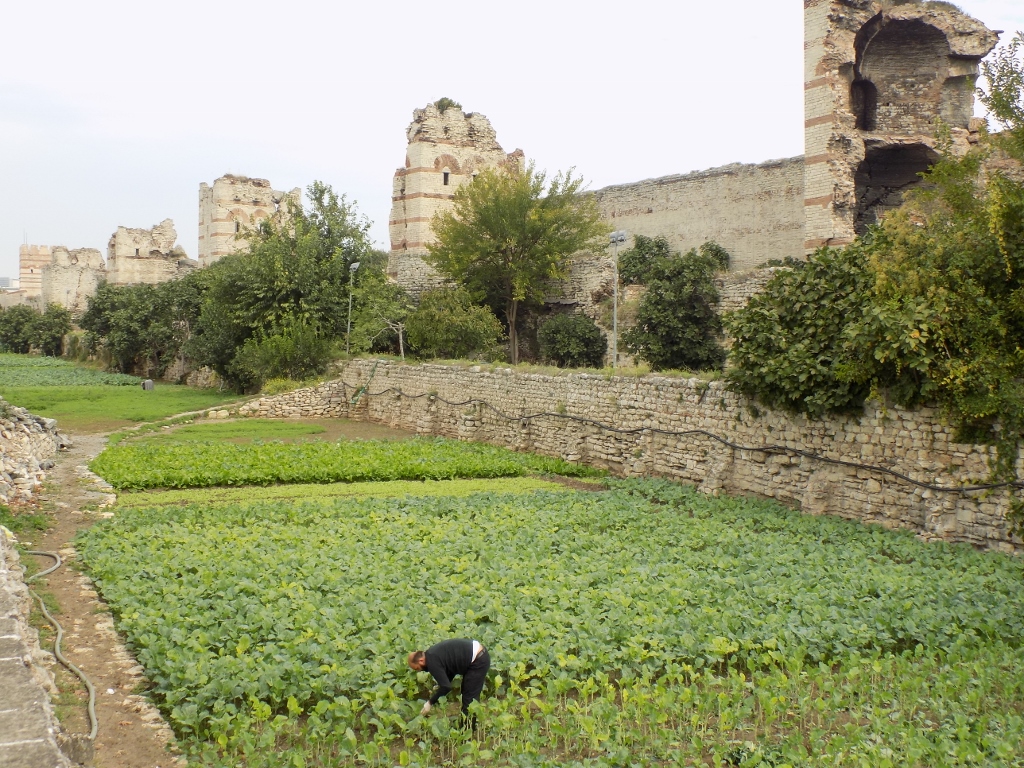 Growing agricultural crops in the wide moat beside the Theodosian Walls
Growing agricultural crops in the wide moat beside the Theodosian Walls
There are agricultural parcels also in the section between the outer and inner walls, and as it may be seen in the following photo, the yield was apparently good this year.
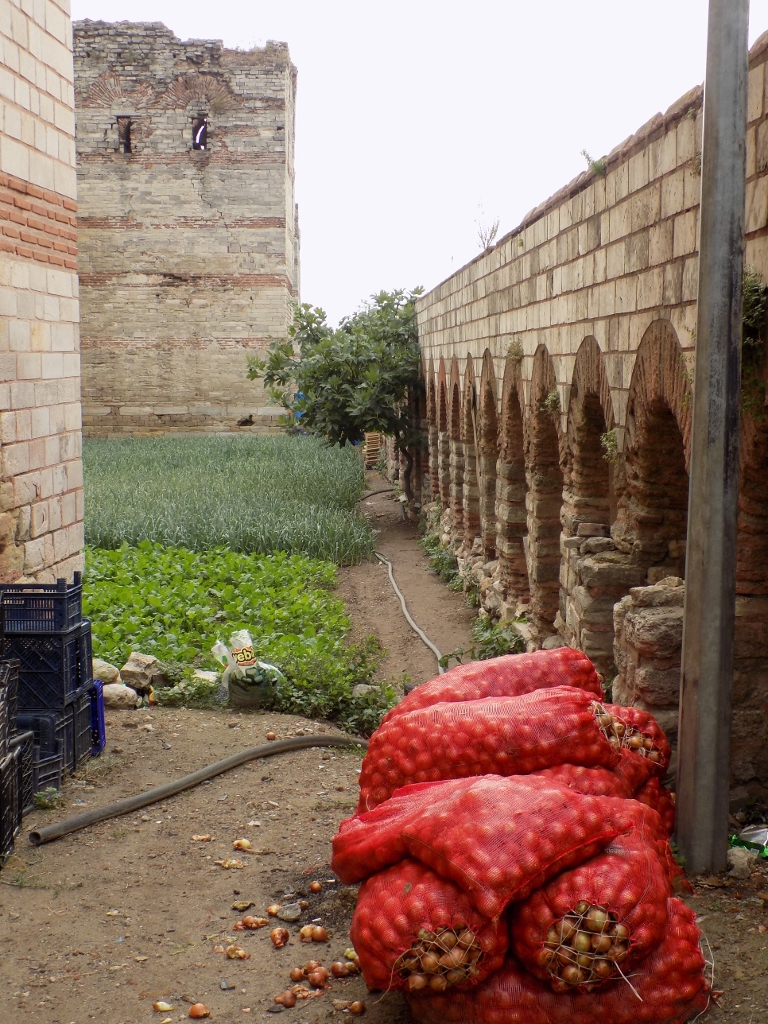 Growing agricultural crops in the section between the inner and outer Theodosian Walls
Growing agricultural crops in the section between the inner and outer Theodosian Walls
And then we also came across a stand where passers-by could buy freshly harvested vegetables. Of course, not the two of us. We like to buy all sorts of things, but not vegetables that we have nowhere to prepare. Although, I must admit, its freshness was luring.
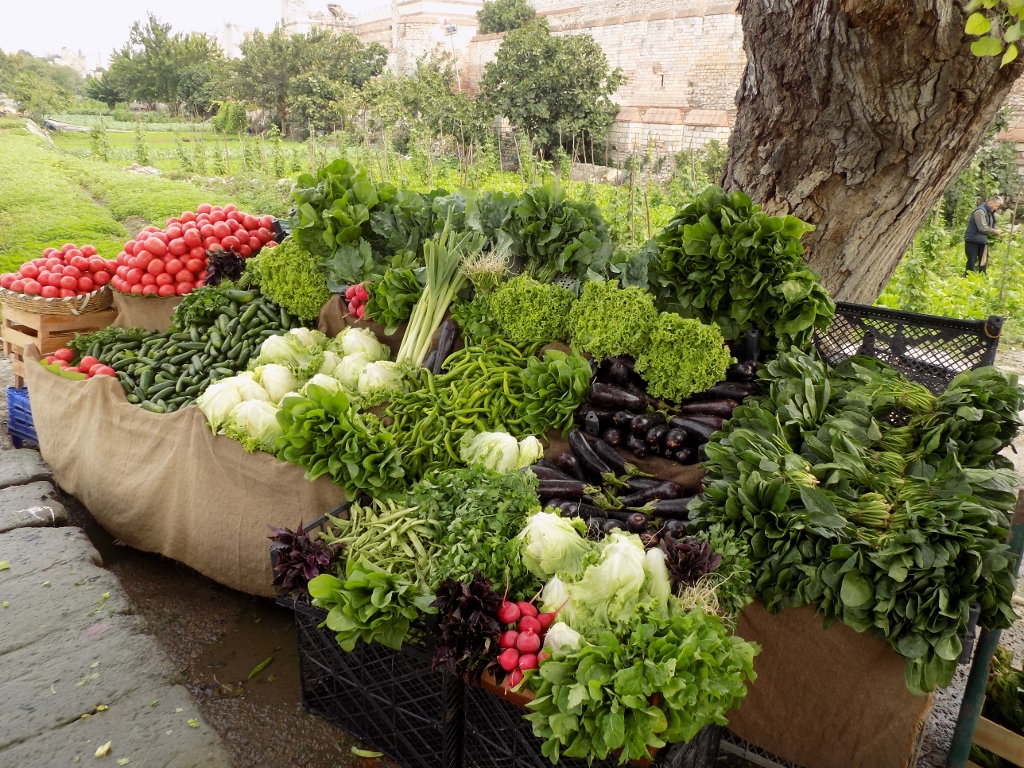 A stand with fresh vegetables
A stand with fresh vegetables
But, let me go back to the topic of the walls. They were built really thoroughly, with a moat and three levels of walls – the low, outer and inner walls. Along the ramparts there are 96 bastions, as well as nine main gates. Of course, for us it was particularly interesting to go to one of these gates because it is called Belgrade Gate. In the next photo showing Belgrade Gate it is possible to see those three walls that I have mentioned above. On the low wall one can see the crenellated parapet, in front of the towers there is the outer wall, while the towers were built as a part of the inner wall.
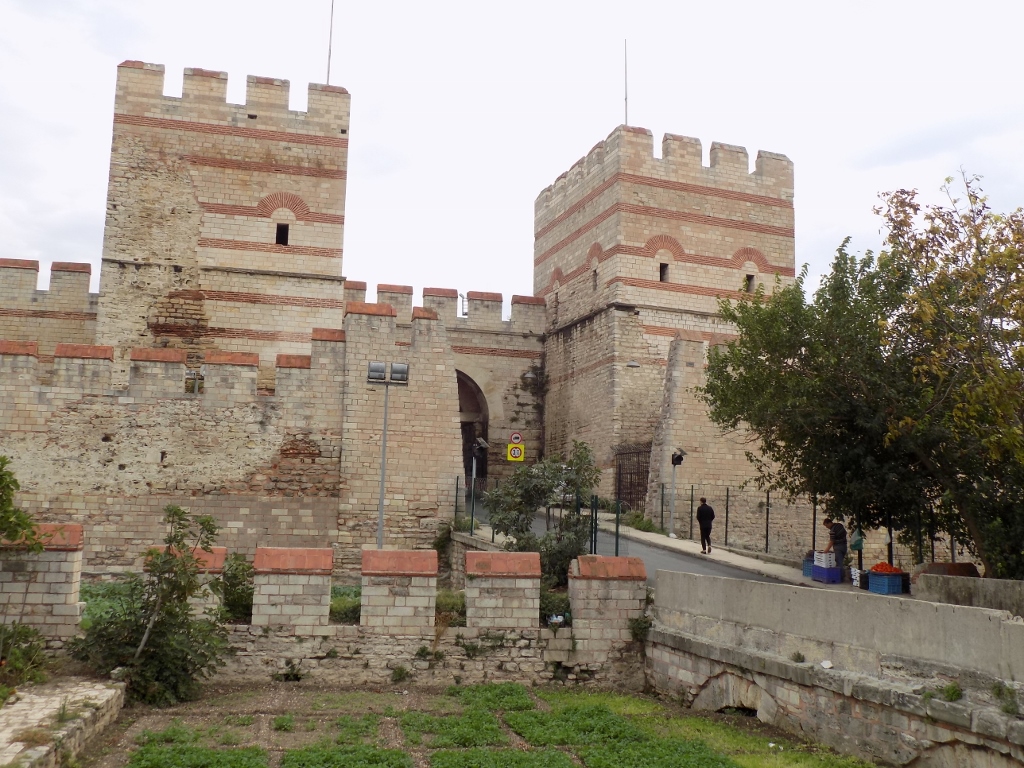 Belgrade Gate
Belgrade Gate
We continued walking along the exterior side of the ramparts, but every now and then we would go through the gates in order to see the walls from the interior side. Already by the next gate, and that was Silivri Gate, when we went to the other side we saw a mosque which was in 1551 built by Vizier Hadim Ibrahim Pasha and which was designed by who other than Mimar Sinan. We had to visit it and we certainly did not regret the decision.
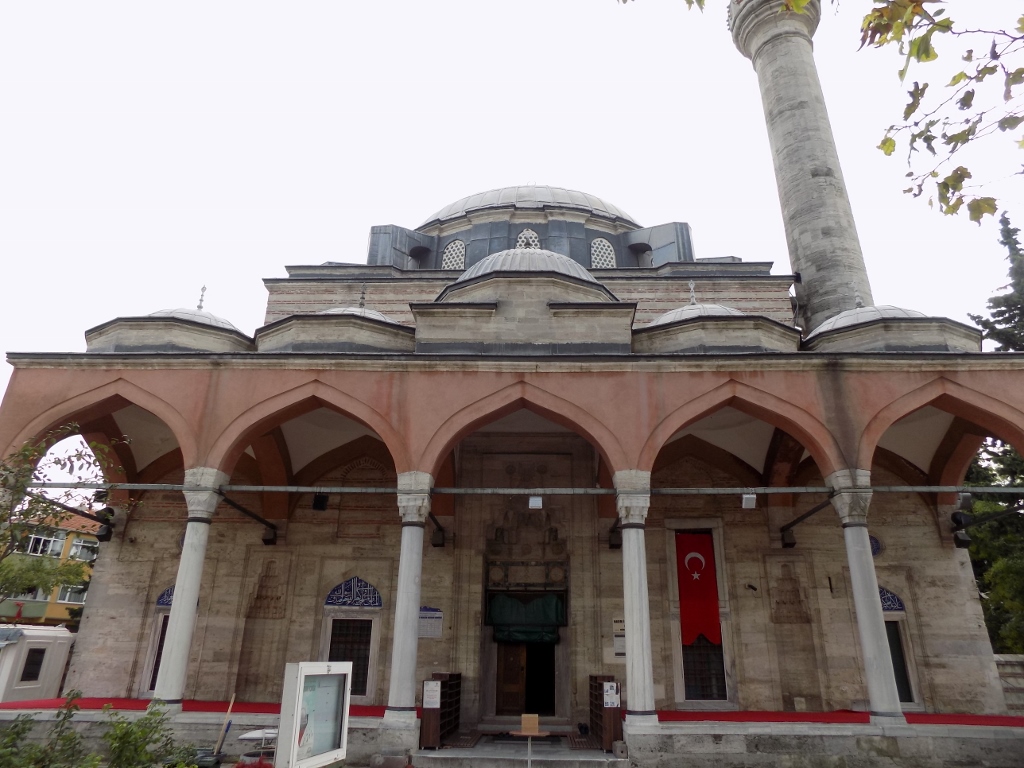 Hadim Ibrahim Pasha Mosque
Hadim Ibrahim Pasha Mosque
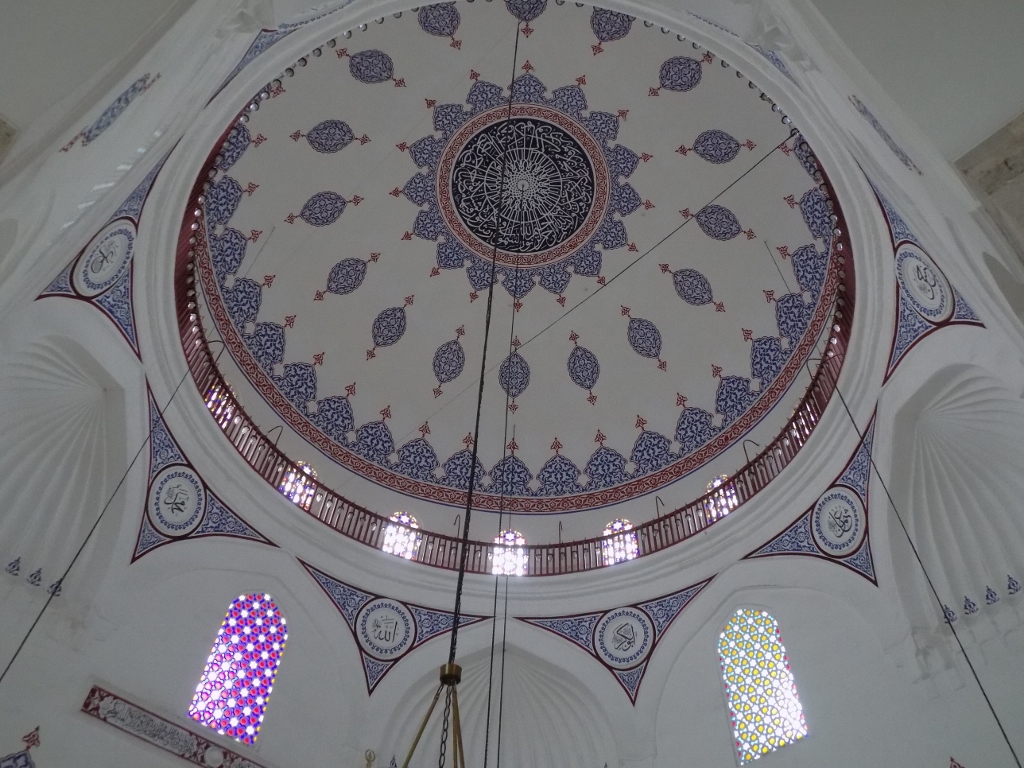 Hadim Ibrahim Pasha Mosque
Hadim Ibrahim Pasha Mosque
We then walked past a few more gates and thus we climbed to the top of the elevation we were walking on. And then, a little farther, on top of yet another elevation we saw a big mosque. I thought that there was no way I would walk there, first downhill and then again uphill, since for some unclear reason I found walking on this particular day very difficult. It turned out that this was indeed the Mihrimah Sultan Mosque that was our next planned destination and that is located by Adrianople or Edirne Gate.
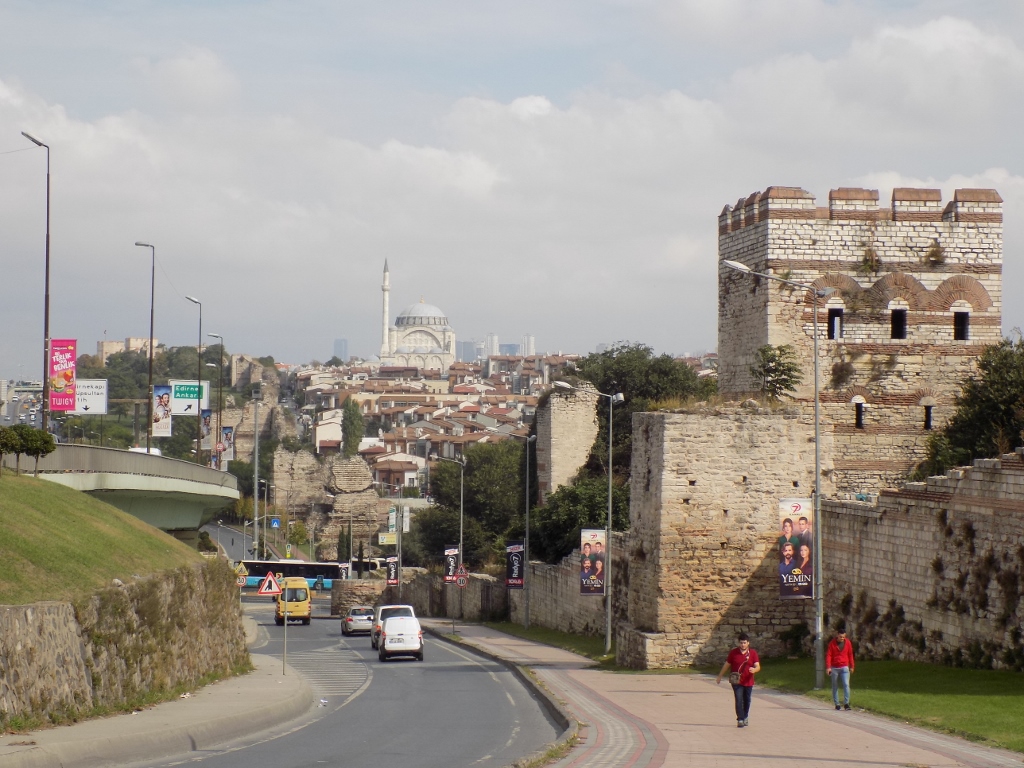 Mihrimah Sultan Mosque in the distance: this is just a small section of the route we covered on foot on this day
Mihrimah Sultan Mosque in the distance: this is just a small section of the route we covered on foot on this day
In order to have the strength and vigour to keep going, we made a break by a kiosk selling food and beverages, since they also had freshly squeezed pomegranate juice.
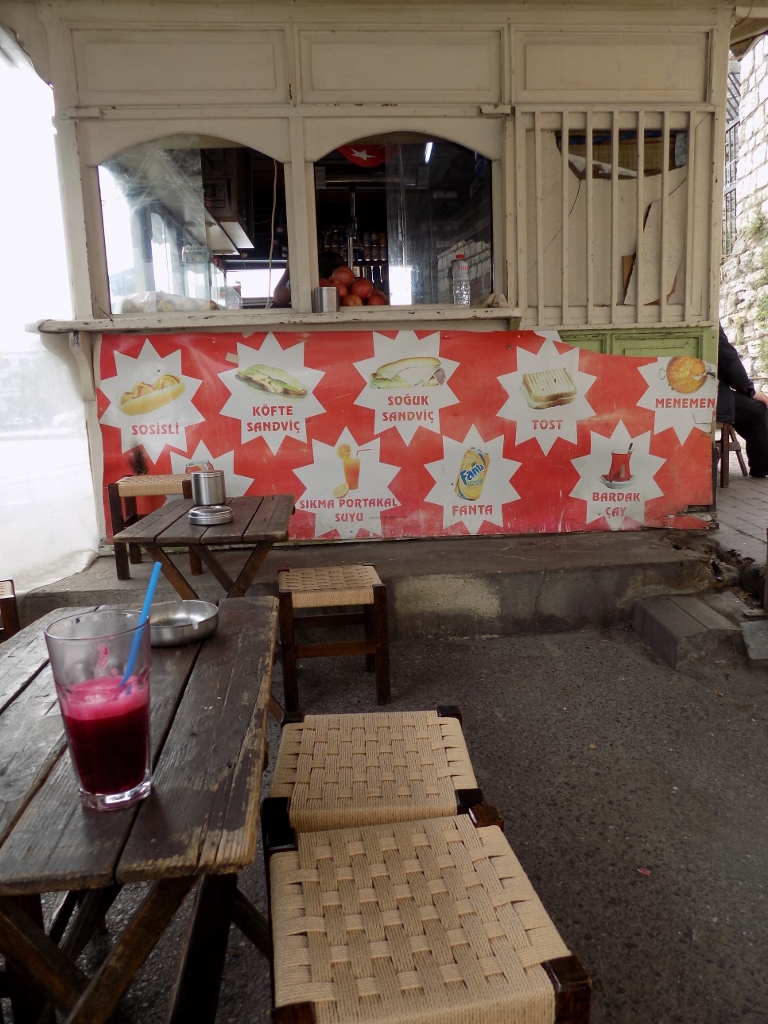 Freshly squeezed pomegranate juice and the kiosk
Freshly squeezed pomegranate juice and the kiosk
The Mihrimah Sultan Mosque complex by Edirne Gate was built in 1565 in line with the design provided by architect Sinan. Mihrimah Sultan was a daughter of Suleiman the Magnificent and Hürrem Sultan, as well as a wife of the Grand Vizier Rustem Pasha. Like her mother, she was also an exceptionally powerful and influential woman at the very top of the Ottoman Empire. There are two mosques in Istanbul built by Mihrimah Sultan, while she herself was buried by her father in the mausoleum beside the Süleymaniye Mosque.
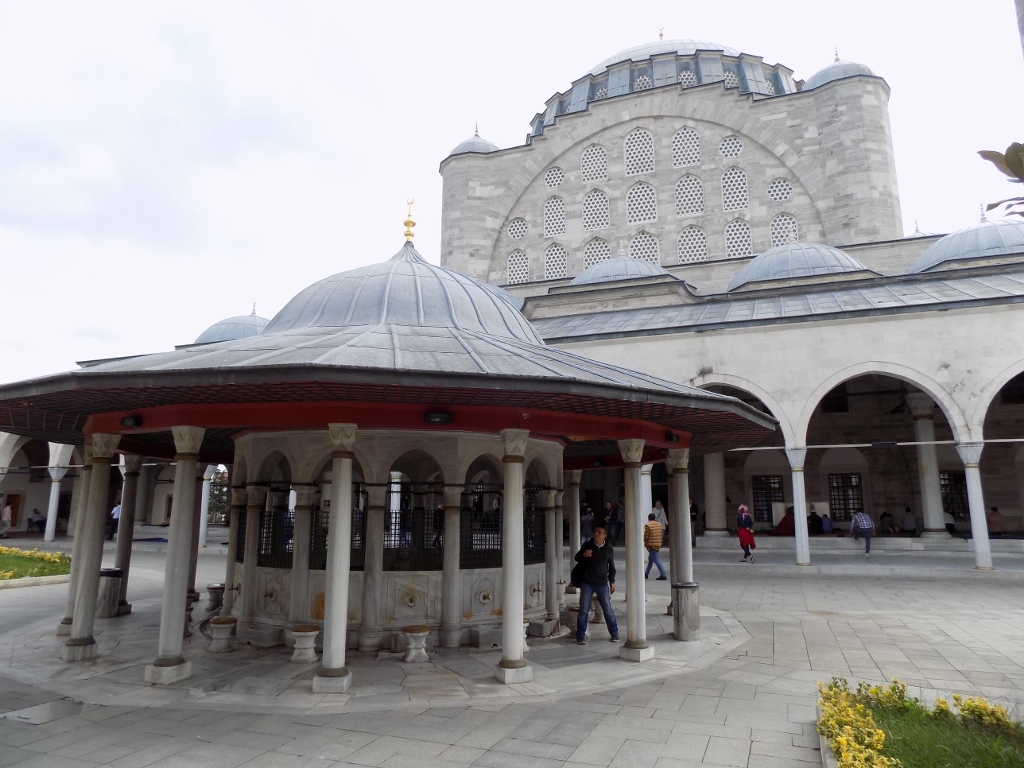 Mihrimah Sultan Mosque with the shadirvan in the forecourt
Mihrimah Sultan Mosque with the shadirvan in the forecourt
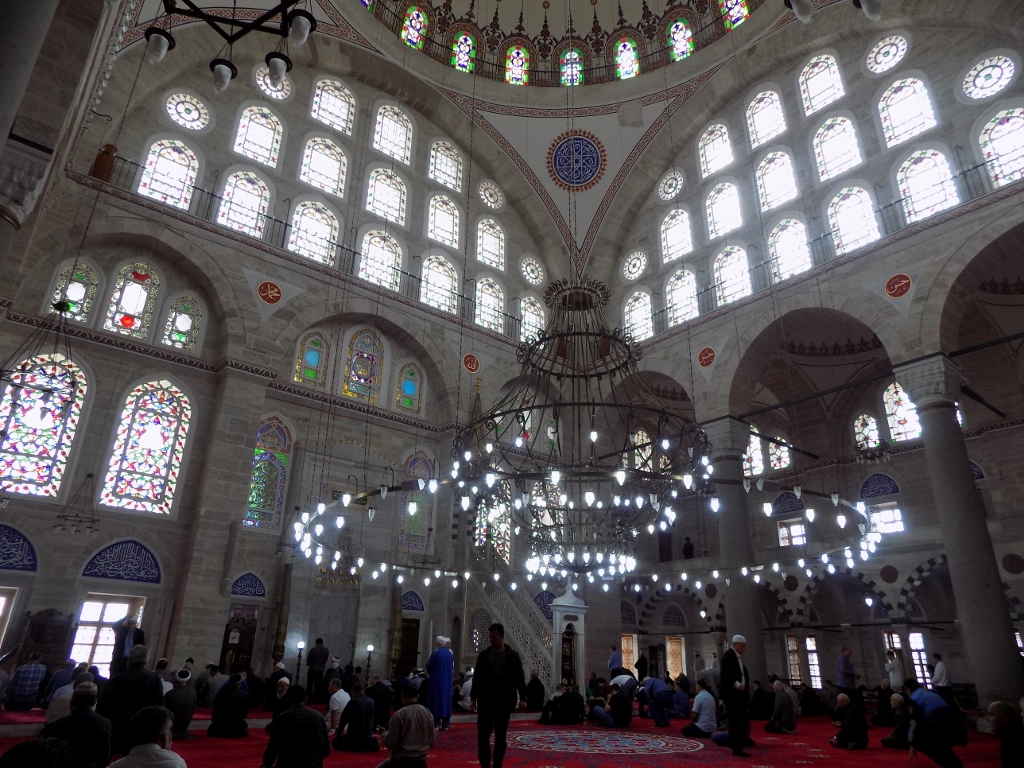 Mihrimah Sultan Mosque; the prayer is going on
Mihrimah Sultan Mosque; the prayer is going on
This mosque stands out in particular by the large number of windows, 204 of them in total, that let the light in. All those windows are decorated by stained glass, but some of them were made more delicately than the others. The overall impression, however, was completely spectacular.
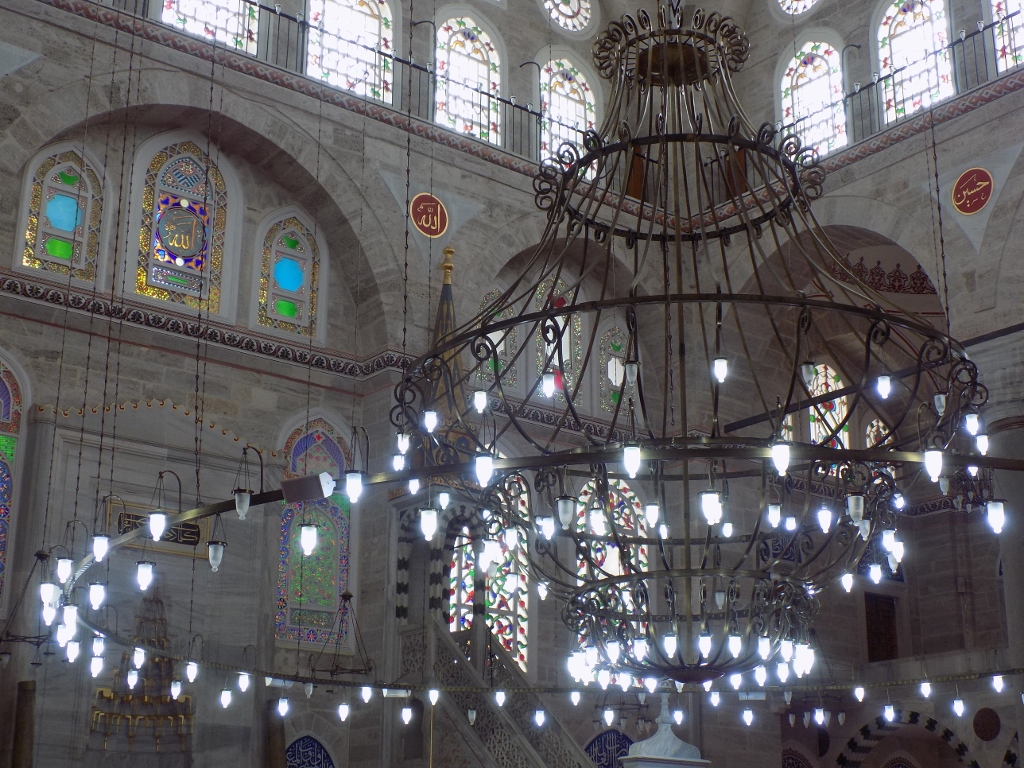 Mihrimah Sultan Mosque: details
Mihrimah Sultan Mosque: details
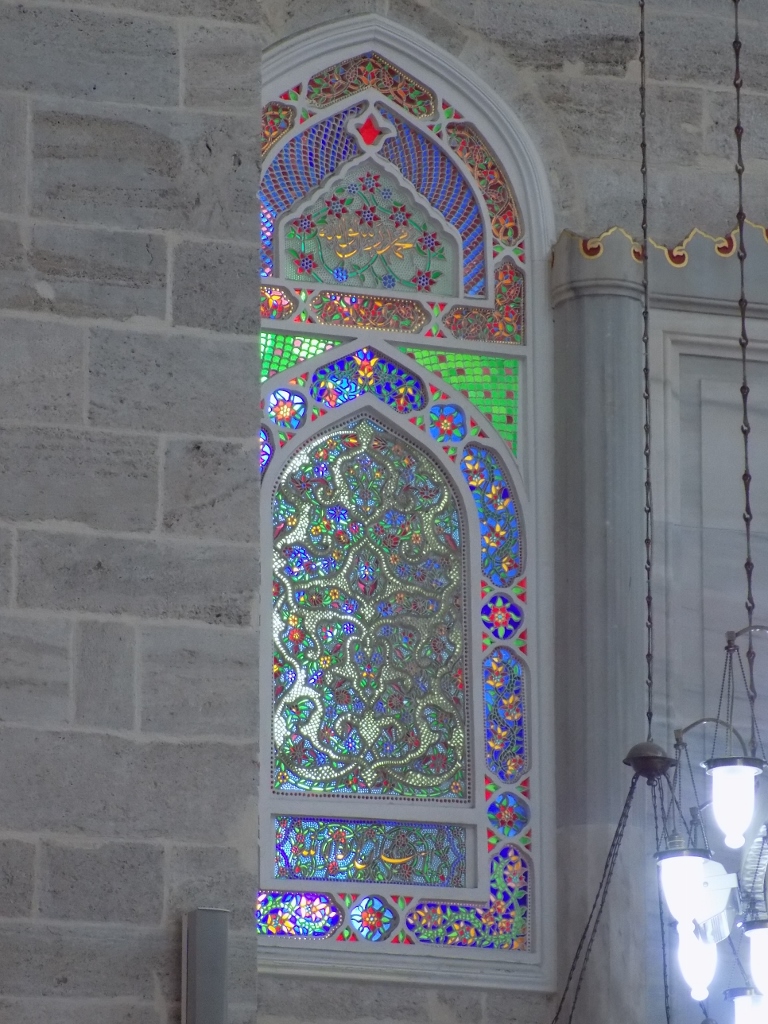 Mihrimah Sultan Mosque: details
Mihrimah Sultan Mosque: details
The dome with its diameter of 19 m and height of 27 m is also very impressive.
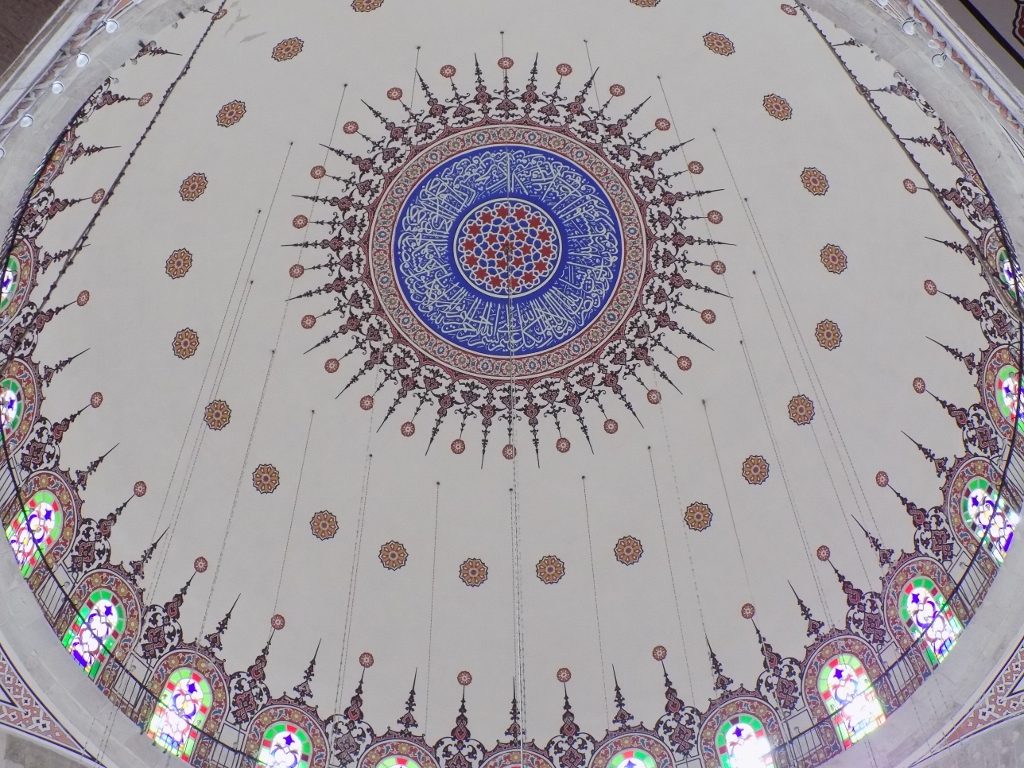 Dome of the Mihrimah Sultan Mosque
Dome of the Mihrimah Sultan Mosque